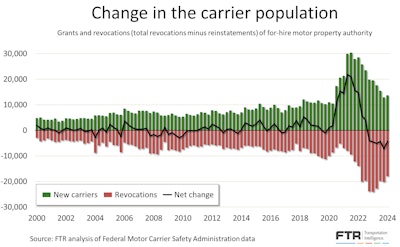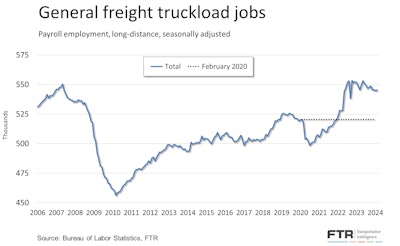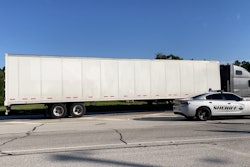As carriers feel the impact of the weak freight market, the possibility of bankruptcy threatens the stability of companies large and small. In recent years, a combination of factors, exacerbated by events such as the global pandemic and shifts in insurance dynamics, has impacted the market.
Looking at Federal Motor Carrier Safety Administration data on revocations from 2000-2024, Avery Vise, vice president of trucking at FTR Transportation Analysis, noted that revocations net of reinstatements peaked in late 2022 and early 2023. Technically, Vise noted, the first quarter of 2023 was the peak at just over 24,000, but it was only barely more than in the fourth quarter of 2022. Since then, revocations have declined mostly steadily, but they are still higher than seen before the pandemic.
 FTR
FTR
“The absolute number of carriers exiting is historically high due to the unprecedented surge in the carrier base, especially in 2021,” said Vise. “Even with the large number of carrier failures, through March, the market still has 94,000 more for-hire carriers than it did immediately before the pandemic.”
Unless there are substantial changes in market conditions for small carriers – such as spot rates or diesel prices – the number of carriers leaving the market “likely will continue to ease incrementally but remain elevated” through most of this year, Vise said. “By late this year or early next year, the market should finally have returned to a pattern that is at least close to normal.”
The wild card
One uncertain factor that could impact the rate of carrier failures is insurance. Based on data from federal government, the costs for commercial auto insurance premiums have been rising for about a year. In March, the Producer Price Index for premiums was up about 2% from March of last year – year-over-year gain not seen since the end of 2019.
“That year is an important benchmark because escalating insurance costs forced many small carriers out of business,” Vise noted. “To date, we haven’t seen a rapid escalation of premiums like we did in 2019, but continued increases might mean more failures than we would expect focusing simply on rates and fuel costs.”
Massive multi-million-dollar verdicts against trucking companies can have significant impact on insurance costs. With insurance one of the main factors affecting a company’s bottom line, Dain Dockter, senior vice president of transportation practice at HUB International, emphasized that there must be a buy-in from the top down that operating a safe fleet is a priority and a responsibility that all staff members share, not just the safety department.
Dockter advised hiring the right people, utilizing fleet safety technology, utilizing a driver training portal, and focusing on total cost of risk more so than insurance cost.
"To continuously reduce the total cost of risk, a fleet must reduce/prevent accident frequency. There are a lot of different programs that can be used to finance risk, but none of them will yield positive results for an insured if loss frequency and severity is on the rise," he added. "A fleet needs to partner with an insurance broker that has the resources to help a fleet reduce/prevent accidents and can finance their risk in a manner that maximizes their return on their efforts to operate safely.”
Dockter noted that there is an overall upward trend on commercial auto liability rates this year, with many of the company’s insurance carrier partners saying that they are looking to increase rates at around 8-12%.
However, he pointed out this would not necessarily mean it’s a hard market as they still have plenty of clients getting flat rate renewals, small increases, or even some decreases. In addition, Dockter said they are still seeing a lot of competition on desirable accounts where the expiring pricing is being undercut by a competing market.
“The market appears to be a in a state of flux right now,” he said. “There are some signals that the market is hardening – a few insurance carriers exiting the market, underwriters being more disciplined in their review of accounts, some insurance carriers taking 20%-plus rate increases across the board, some insurance carriers reducing the limits they will provide, etc. – but on the flip-side, there have been some new markets bringing capacity to the space, and several of our insurance carrier partners are aggressively trying to add market share.”
Will the decrease of capacity strengthen the industry?
While bankruptcies are tough for the market and lead to a ceasing of operations and reduction in the number of available trucks and drivers, could the capacity decline strengthen the industry? Vise pointed out that the trucking industry needs capacity to fall further to get back to a “healthy utilization and freight rate environment.”
Though FTR expects some recovery in truck freight beginning around the middle of the year, volume alone will not significantly strengthen market conditions without more capacity leaving the market.
However, Vise noted that carrier failures – most of which are single-truck operations – are only one piece of the puzzle. Many of the drivers displaced by small carrier failures have taken jobs at larger truckload carriers and have also taken much of the volume that had shifted to the spot market from late 2020 through early 2022. “As of February, payroll employment in general freight truckload is down only about 1.5% from its all-time high,” he said.
 FTR
FTR
Surprisingly, the first quarter witnessed an uptick in new entrants, said Vise. However, it seems that spot rates have hit their lowest point and diesel prices have leveled off. This may suggest that more drivers may be assessing the situation and anticipating a potential market upturn, prompting them to enter the industry early. “We won’t see a surge in new entry – if at all – until spot rates begin rising steadily, but we might have at least seen a stabilization following the steady decline in 2022 and 2023.”
Strategies for risk mitigation
Looking ahead, Vise said a fundamental strategy is doing everything possible to maintain positive cash flow. From minimizing empty and out-of-route miles and maintaining productivity, this could mean taking some loads with less-than desirable rates to cover fixed and variable costs.
For carriers experiencing financial distress or on the verge of struggling, Dockter said it’s worth looking into factors on why a fleet is struggling. “A fleet needs to really drill down on where the profitability is within their fleet and where the inefficiencies are occurring,” he said.
Dockter pointed out, “Are there certain customers, lanes, tractors, drivers, or commodities being hauled that aren’t profitable? Is there opportunity to increase the fleet’s fuel efficiency by governing the trucks or through driver training or fuel efficiency incentives for the drivers? Will their lender accept interest only payments for a while until the freight market improves? Should driver pay be adjusted due to market conditions? From a risk standpoint, is there an opportunity to finance the risk with a different structure or with a different provider to reduce the total cost of risk? These are just some of the questions that a fleet should be reviewing if they are having financial struggles right now.”











